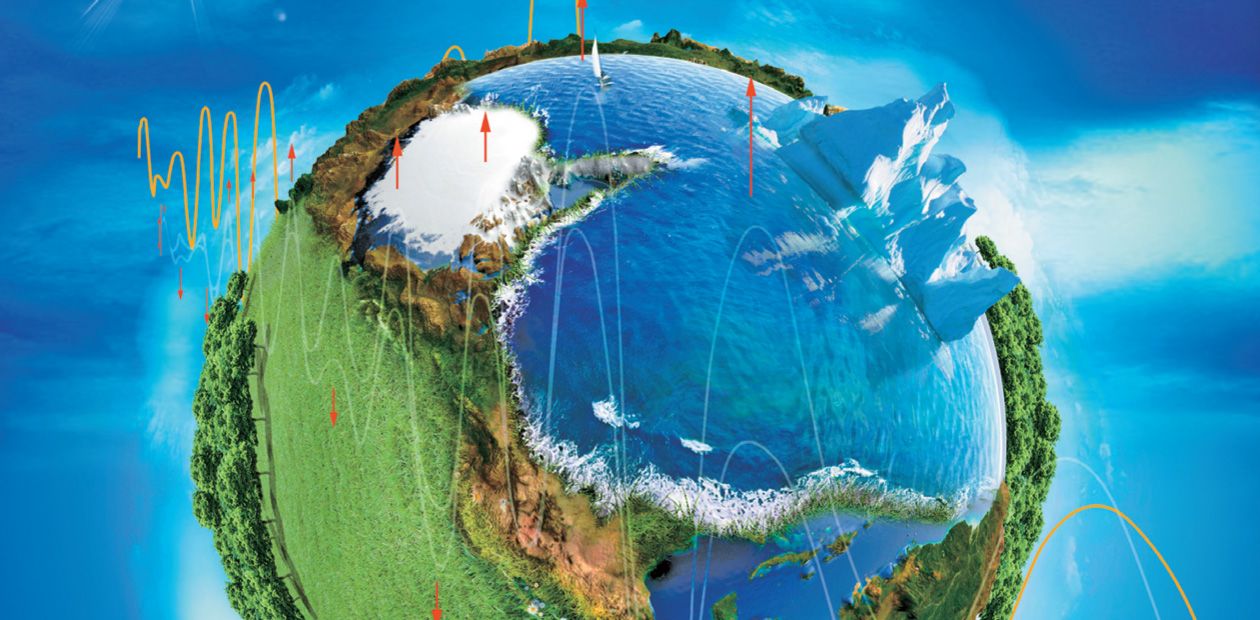4 E’s of Our Life. Comments to the monograph by Robert Nigmatulin
The essays by the RAS Academician Robert Nigmatulin, published in the form of a small monograph, are based on his lectures at St. Petersburg Humanitarian University of Trade Unions and his presentations at Russian and international conferences. These essays are remarkable in that they raise the most pressing sociopolitical and science issues. The four phenomena mentioned in the headline—the key issues of our time—are discussed in the four chapters of the book, with economy and ethnos being discussed in most detail.
Responding to Nigmatulin’s call that “scientists must analyze the concerns of their Fatherland, not only those associated with their narrow professional field,” I make brief comments on some (far from all!) of the issues raised by the author in the order in which they come in his book
Ecology and climate
In April 2015, I had a chance to take part in a debate on Nigmatulin’s report Problems of Climate, which he made at the Presidium of the Russian Academy of Sciences. Based on that report, the debate, and on my previous works (Global Changes..., 2001; Dobretsov, 2013; etc.), I would like to highlight some inaccuracies and unresolved problems:
(a) The climate change on the Earth comes from the interaction of the three external geospheres, i.e., atmosphere, hydrosphere (oceans), and cryosphere, which is influenced by the processes in the solid Earth (in particular, volcanism) and external factors (solar radiation intensity). The multifactor and multiscale nature of these influences results in the huge complexity of the processes affecting the climate change.
I will tell you about something I have been meditating over for many years. This is not always related directly to my official field of work, which is physics and mathematics, or, to be more specific: hydrodynamics and thermodynamics. I studied the processes in multiphase systems, in particular, explosions. I was engaged in chemical and nuclear technology, theory of oil and gas production, and analysis of ecology and safety issues. I have published works on economic theory. Working in Siberia, Bashkortostan, the United States, France, and United Kingdom as well as in Moscow, I had to analyze the interethnic interactions within the civic society of a nation.![Robert Nigmatulin, an outstanding scientist and public figure. Full Member of the RAS; Doctor of Physics and Mathematics; Director of the Shirshov Institute of Oceanology RAS (Moscow) and Head of Department at Moscow State University. Awarded with the USSR State Prize. Deputy of the State Duma in 1999–2003. Nigmatulin, R.I. 4 E’s of Our Life [in Russian]. 107 pp.: ISBN 978-5-4235-0181-5 Robert Nigmatulin, an outstanding scientist and public figure. Full Member of the RAS; Doctor of Physics and Mathematics; Director of the Shirshov Institute of Oceanology RAS (Moscow) and Head of Department at Moscow State University. Awarded with the USSR State Prize. Deputy of the State Duma in 1999–2003. Nigmatulin, R.I. 4 E’s of Our Life [in Russian]. 107 pp.: ISBN 978-5-4235-0181-5](/files/medialibrary/292/29231f854a21d04acc13d6fbe53fa25c.jpg)
This brochure presents my reflections in the form of essays on some (not all) of the key aspects of climate, new energy technologies, macroeconomic growth, and interethnic relations.
<...> I have seen a period of robust growth of science in Russia, and I have met some prominent people. They taught us lessons with their style of reasoning, which was not always entirely positive, since the scientist is a contradictory structure, sometimes prone to excess ambition. Understanding the interdisciplinary range of problems is very important, especially now, since science has undergone a tremendous differentiation.
Many crawled into their "holes" and had no idea whether what they were doing was necessary. Scientists came to share the bureaucrats’ view that politics is a dirty business, so let us leave it to "professionals," meaning government officials and political party figures. But then everything is hopeless because politicians and administrative officials are not the most reliable stratum of the mankind.
The French statesman Georges Clemenceau once said: "War is too important to be left to the generals." I can paraphrase this crucial thought into the following idea: strategic problems of a nation, including economic ones and those associated with power, are too important a matter to be fully entrusted to the bureaucracy and political parties.
However, it is very important for scientists and cultural figures who make their way to politics to overcome temptations, maintain a distance from power authorities, uphold their sovereignty, and "make others respect them."
It is extremely difficult. Especially when the science is not in demand in society. Another important idea was formulated by the American physicist Josiah Gibbs: "One of the principal objects of research in my department of knowledge is to find the point of view from which the subject appears in the greatest simplicity."
However, finding this point is not easy. To do this, you need to know theorems, draw charts, conduct experiments and analyses, and make calculations. Moreover, this should be done by professionals. However, in the end, when the professionals have understood and found such a "point of view," they should be able to explain their result to any thinking person. This is very important. Most scientists do not know how do it.
Like in Osip Mandelstam’s poem:
We live without sensing the country under our feet,
Our words inaudible ten steps away...
The participants of the discussion rightly pointed out that the atmosphere is changing very rapidly (“it doesn’t remember what it was a week ago”) and determines variations in the weather, not in the climate. Nigmatulin himself correctly noted that “temperature changes first, and only then does CO2 concentration change”(i. e., a change in temperature causes an increase in CO2, not vice versa) and that “the existing models might overestimate the effect of carbon dioxide on climate by hundreds of percent.” The reason for the latter is that the change in air temperature near the surface depends on the thermal and temperature conductivity not only of the air but, to an even greater extent, of the ocean and solid earth, which are not affected by small CO2 concentrations.
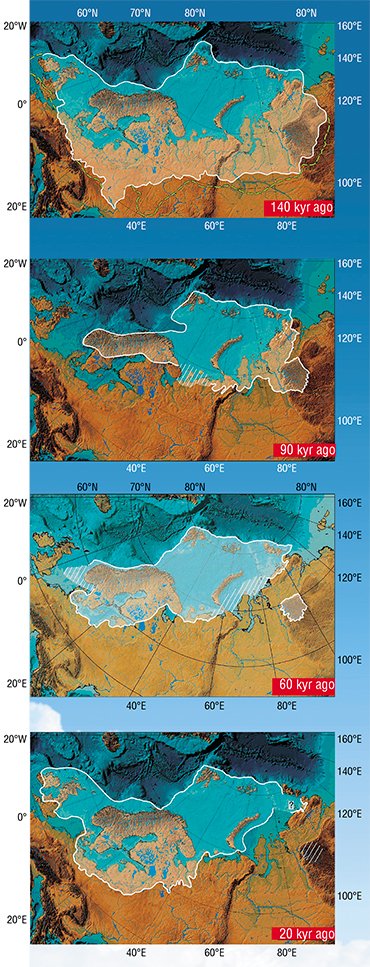
Moreover, the formation of plankton biomass in the oceans also affects the circulation of oxygen and the processing of carbon dioxide, which are part of the even more global organic/inorganic carbon cycle.
(b) Nigmatulin concludes that “the ocean has a decisive effect on climate,” which is true for periods of climate change lasting tens or hundreds of years. For more longterm changes, the cryosphere is of major importance, since it is the volume of ice that determines the sea level, which fluctuated up to 120 m over the last million years (instead of 1–2 m, which the modern warming threatens us with). The change in the volume of ice and the sea level can be estimated accurately enough by the change of the oxygen isotopes ratio in the marine sediments and organisms; therefore, the best research method here would be palaeontological reconstruction.
Today, the bulk of ice is located in Greenland and Antarctica. The measurements of the patterns of change in the ice cover are insufficiently accurate and reliable. However, there is more and more evidence suggesting that in the past half a century, the volume of ice in the Arctic was diminishing whereas in Antarctica it was growing. As noted in the discussion, the opposing trends of climate change in the northern and southern hemispheres are “the climatology’s main challenge.”
(c) The same climatic trends are responsible for more local yet more practically relevant phenomena such as the patchy climate change, i. e., the multiple abnormal changes in the weather in some areas over the past 15–20 years. For example, one could observe warming and reduction of the ice area on most of the Arctic territory during 30–40 years, but the last decade (especially in 2014) showed the opposite trends. At the same time, in the part of the Arctic adjacent to Greenland and the Baffin Island, there have been these trends over the last 12,000 years (de Vernal et al., 2005).
(d) Climate change depends on humidity as well as temperature, but the former does not always correlate with the latter.
Thus, the Earth’s history has seen both “wet” warm and cold periods and “dry” cold and, more rarely, “dry” warm periods. The extent of desertification depends on the topography and the degree of inland penetration of the wet monsoons. In particular, the desertification in Central Asia has increased in the last 5 to 10 million years with the growth of the mountains—the Himalayas, Tien Shan, and Altai. Even in the last half-century, the situation has worsened in some areas of Central Asia, evidenced by the “drying” of glaciers and the movement of “treacherous sands,” which are encroaching on settlements and highways.
(e) All of the above means that the current climate change must be weighed against the paleoclimate. The only problem is that we cannot yet identify changes in the paleoclimate with sufficient accuracy. Scientists’ mission is not only to improve the accuracy but also analyze the long-term trends in climate change in the coming 50 to 100 years. In so doing, they first should pay attention to the selection of the averaging time intervals.
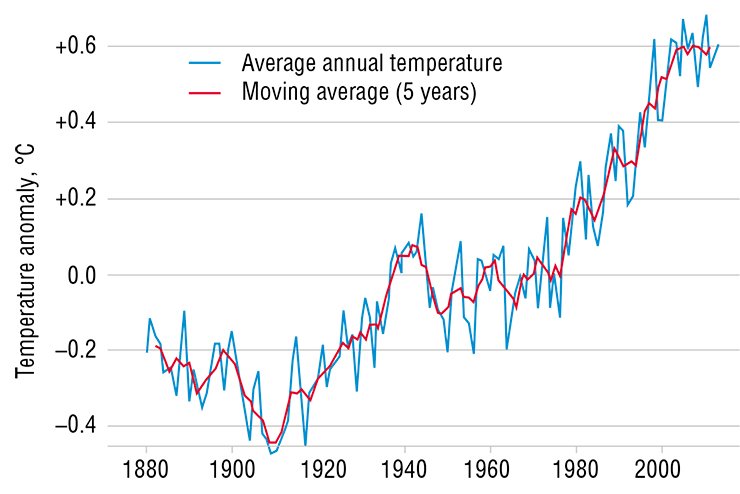
Second, the “patchiness” of climate change dictates the need to study amplitudes and places of maximum amplitude (with a high concentration of abnormal weather phenomena such as floods, droughts, unusual cold snaps, etc.) rather than the “averages.” For example, according to the Federal Service for Hydrometeorology and Environmental Monitoring of Russia (Roshydromet), the number of anomalous phenomena in Russia has increased by a factor of 3 over the last 15 years and may increase by a factor of 10 in some areas by the end of this century.
Energy sector and its future
An outstanding expert in mechanics, hydrodynamics, and thermodynamics, Nigmatulin provides a professional discussion of the contiguous fields associated with the energy sector. However, the second and the shortest chapter, does not cover all the problems and contains some inaccuracies.

I would like to mention three of them:
(a) First of all, this chapter reiterates the “depletion myth” associated with hydrocarbon energy sources. However, it is uneconomical to explore oil and gas deposites for more than 25 years into the future; therefore, it is necessary to distinguish between proven and potential (initial) hydrocarbon reserves. The potential reserves are tens or hundreds of times larger and are evaluated (explored) as needed: every region has its own strategy taking into account the existing infrastructure.
It is true that traditional deposits, first of all those with “cheap” oil and gas, become depleted relatively quickly. When need arises, we will come to use the “difficult” hydrocarbons such as shale gas and oil, viscous and heavy oil, bitumen, etc. Most importantly, we increase the extraction from new hydrocarbon sources such as oil from parent formations (e. g., the Bazhenov formation in West Siberia, which dates back to the Late Jurassic) and gas hydrates in the vast expanses of marginal seas and oceans. The potential reserves of these sources can supply the humanity for hundreds of years!
(b) According to my estimate for the use of traditional and new energy sources, which is close to the estimates by Alexey Kontorovich (2014; 2015), by the end of this century, the share of fossil fuels (including coal) will drop to 50%. Each energy source will have its own niche.
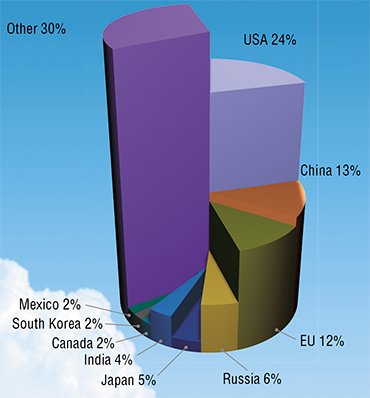
The bulk of oil, gas, and coal will go to oil, gas, and coal chemistry. Electricity will be produced from coal, partly from gas, and from new sources of energy (primarily, gas hydrates) as well as the increasingly popular renewable energy sources (the Sun, wind, small rivers, plant biomass, fusion energy, etc.). The new highly efficient power batteries will play a more important role.
(c) Nigmatulin’s conclusion that 90% of industrial energy is consumed by 25% of the Earth’s population, which live in industrialized countries (Europe, North America, and Japan) is generally fair and requires a new energy policy (Kontorovich, 2014; 2015).
The matter is complicated by the high differentiation in power consumption and wealth (per capita income) at the end of the twentieth century (Dobretsov et al., 1999; 2000). Three evolutionary trends had formed by 2000:
• Increase in energy consumption up to 3–5 toe per capita per year in countries with a low GDP of $5,000 per capita or less.
By the way, oil-producing countries, such as Iran, Iraq, Mexico, and Venezuela, fall into this category.
At a meeting in Novosibirsk in November 2000, Vladimir Putin suggested that this state of affairs in these countries was due to their insufficiently free market economies and the excessive government intervention into economic processes.
• The most industrialized nations (Japan, Switzerland, Germany, Austria, France, and Italy) show the same growth in energy consumption (4.5–6 toe per capita per year) against a ten times greater per capita GDP of $30,000–40,000.
• In Canada, the United States, and Norway, a high per capita GDP of $30,000–40,000, which is characteristic of developed countries, demands an even higher growth in energy consumption, 12–15 toe per capita per year!
The global concerns of energy consumption are closely linked to the global economic problems that we will discuss below.
Economy: how to ensure economic growth?
Neither me nor Nigmatulin can consider themselves as experts in economics. He referes to his works published together with economists (Nigmatulin, Nigmatulin, 2010; Nigmatulin et al., 2012) and some works published by economists (Glaziev, 2014 ; Khasbulatov, 2014; Gubanov, 2015). I can only refer to my past work written in partnership with Kontorovich and with economists (Dobretsov et al., 1999; 2000).
(a) In these papers we formulated the need to work out a development strategy for Russia and its key regions (including Siberia), as opposed to spontaneous actions based on the idea that “market will settle everything down.”
We identified the following key issues for Siberia and Russia as a whole:
• The high capital intensity of major projects.
• Harsh environmental conditions and long distances.
• The low standard of living of most people and the ensuing socioeconomic crises.
• Inefficient management of natural resources.
We proposed the following areas of reform and funding sources:
• Optimize the mineral resources management and redistributing financial resources across territories to ensure growth of consumer demand.
• Use the technology and production potential of the military industrial complex and the (still!) high potential of the Russian science and education system.
• Capitalize on Russia’s geopolitical and transport advantages (the fact that Russia is a “bridge” between China and the West, the Northern Sea Route, etc.). This concept is similar to Nigmatulin’s recommendations, but includes a number of important factors apart from growth in consumer demand.
(b) The release of Capital in the Twenty-First Century by Thomas Piketty (2014) spurred a heated debate around another economic aspect: the excessively rapid growth of financial capital in comparison with industrial capital and the corresponding slowdown and cessation of economic growth on a global scale.
Piketty formulates the basic contradiction of capitalism using the inequality r > g, where r is the rate of return on capital and g is the rate of growth of income and output. In a long period of time, r is much higher than g. This situation creates powerful divergence forces that destroy the democratic society and the underlying social equilibrium.
The myth of “market fairness” whereby the well-being of an individual is based on their knowledge and hard work is not supported by a careful socioeconomic analysis in ten developed countries over the last 200 years. For a business perseon, it is more profitable to be a rentier rather than intensify his/her work.
This 200-year pattern was interrupted only in 1915–1970 due to the “non-market” redistribution of capital during the great revolutions and the two world wars. An important role was also played by Roosevelt’s reform (involving Wassily Leontief, who won the Nobel Prize in Economics).
Since the 1990s, the growth of financial capital has accelerated because of two factors: the collapse of the Soviet Union accompanied by the “non-market” development of the class of “oligarchs” in Ukraine and Russia and the United States’ strive to financial (as well as military, political, diplomatic, etc.) hegemony.
A deeper discussion of Piketty’s book and at the ensuing wave of critical comments is beyond the scope of this article. The general conclusion is, however, that we need to quickly and consistently change the tax, customs, banking and anticorruption legislation on a global scale; otherwise, by the end of the century, 99% of the capital would be concentrated in the hands of 1% of the rich financiers. Russia risks being a loser in the coming financial turmoil. One of the few factors slowing down the concentration is the processes taking place in modern China.
The ethnos, the people, the history
Not an expert in the field, I can only make brief comments showing my personal interest in some of these issues.
(a) The study of the human genome is one of the most complex problems, which has seen some progress, as far as I know, only in recent years. Nigmatulin makes an interesting statement that “the Russians are 98% Ugro-Finns by origin, not the Slavs. However, the Tatars are 92% Ugro-Finns by their biological origin too.” But this contradicts the numerous genotypic studies of the indigenous peoples of Russia, according to which their heredity is a mixture of very different fragments of most diverse genomes taken in different proportions. During four millenia B.C., the history of the Altai and West Siberian population was defined by a very complex chain of migrations and mixings (Molodin et al., 2013), and the evolution of the ancient human’s genome is even more complicated (Derevyanko, 2015).
(b) The term indigenous peoples applies only to the last three millenia. 16,000-12,000 years ago, a large part of the Russian territory was covered by a glacier; as it retreated, humans were continuously migrating and settling along the glacial lakes and streams. Over the last 2,500 years, nomadic civilizations (the Xiongnu, Mongols, Uyghurs, Turks, etc.) redrew the map of Asia several times, and each such redrawing was accompanied by movements of huge masses of people (Bazarov et al., 2004).
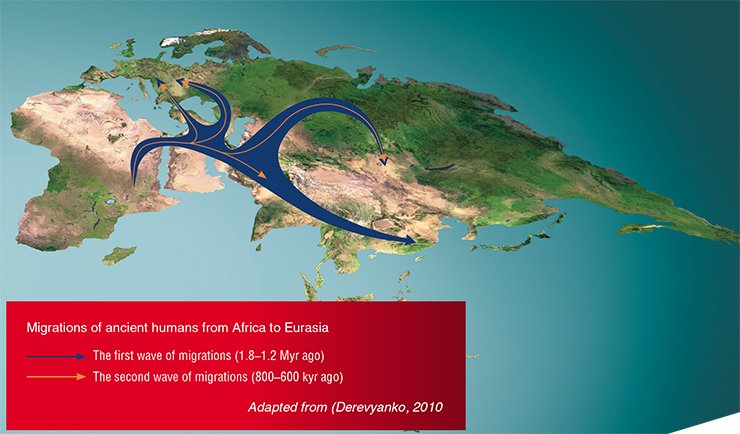
In a long historical period, all ethnic groups can be viewed as “newcomers,” but they usually interacted closely with the previous ethnic groups.
References
Bazarov B.V., Kradin I.N., and Skrynnikov T.D. Mongol’skaya imperiya i kochevoi mir (Mongolian Empire and Nomadic World). Ulan-Ude: Buryat. Nauch. Tsentr, 2004 [in Russian].
Glaziev S.Yu. Kak ne proigrat’ v voine (How not to lose the war) // Nash Sovremennik. 2014. N 10, pp. 147—165 [in Russian].
Dobretsov N.L. Osnovy tektoniki i geodinamiki (Fundamentals of Tectonics and Geodynamics). Novosibirsk: Novosib. Gos. Univ., 2013 [in Russian].
Dobretsov N.L. and Kovalenko V.I. (Eds.) Global’nye izmeneniya prirodnoi sredy (Global Changes in the Environment). Novosibirsk: Sib. Otd. Ross. Akad. Nauk, 1998 [in Russian].
Dobretsov N.L., Kontorovich A.E., Laverov N.P. et al. Energy strategy of Russia in the 21st century // Vestn. Ross. Akad. Nauk. 1999. Vol. 69, pp. 771—789 [in Russian].
Dobretsov N.L., Kontorovich A.E., Kuleshov V.V. et al. Gosudarstvennaya kontsepsiya razvitiya Sibiri na dolgosrochnuyu perspektivy. Iskhodnye materialy k proekty (Long-Term State Development Concept for Siberia. Draft Materials). Novosibirsk: Sib. Otd. Ross. Akad. Nauk; GEO, 2000 [in Russian].
Kontorovich A.E. Oil and gas of the Russian arctic: history of development in the 20th century, resources, and strategy for the 21st century // SCIENCE First Hand. 2015. N 2(41), pp. 42--61
Molodin V.I., Pilipenko A.S., Chikisheva T.A., et al. Mul’tidistsiplinarnye issledovaniya Barabinskoi lesostepi IV—I tysyacheletiya do nashei ery: arkheologicheskie, paleogeneticheskie i antropologicheskie aspekty (Multidisciplinary Studies of the Baraba Forest-Steppe in the 4th—1st Millennium B.C.: Archaeological, Paleogenetic, and Anthropological Aspects. Novosibirsk: Sib. Otd. Ross. Akad. nauk, 2013 [in Russian].
Nigmatulin R.I. 4 E nashei zhizni: ekologiya, energetika, ekonomika, etnos (4 E’s of Our Life: Ecology, Energy, Economy, and Ethnos). Moscow: Litterra, 2015 [in Russian].
Nigmatulin R.I. Nel’zya prozhit’ bez pravdy sushchei (We cannot live without the truth) // Vestn. Ross. Akad. Nauk. 2002. Vol. 72. N 7, pp. 618—629 [in Russian].
Nigmatulin R.I. Kak obustroit’ ekonomiku i vlast’ v Rossii (How to Organize Economy and Power in Russia). Moscow: Ekonomika, 2007 [in Russia].
Nigmatulin R.I. and Nigmatulin B.I. Krizis i modernizatsiya v Rossii: 13 teorem (Crisis and Modernization in Russia: 13 Theorems). Moscow: GeoTar-Madia, 2010 [in Russia].
Nigmatulin R.I., Chuev A.V., Abramov M.D. et al. Modernizatsiya Rossii: problem i puti resheniya (Modernization in Russia: Problems and Solutions). Moscow, 2012 [in Russia].


